In a pesticide-free garden, many types of beneficial insects help to keep problem insects, such as aphids, in balance. One of the most attractive and interesting of these beneficial insects is the syrphid fly.
Syrphid flies are colorful, charismatic and fun to watch and can be easily supported with a variety of flowering plants. The adults are good pollinators, regularly visiting flowers for nectar and pollen. Turn over a leaf on a plant afflicted with aphids and you will find syrphid fly larvae swinging their heads from side to side catching and devouring their aphid prey. What more could a gardener ask for in a beneficial insect?
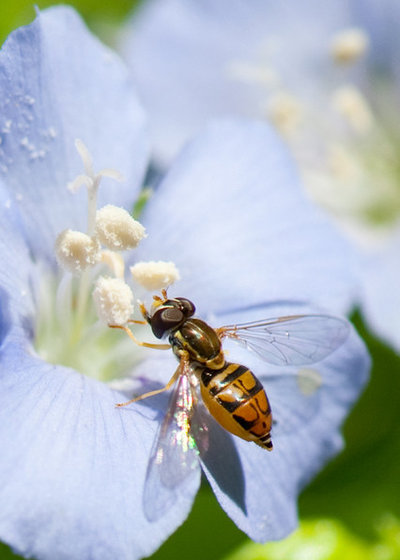
Holm Design & Consulting LLC
Latin name: Family Syrphidae, subfamily Syrphinae
Common names: Syrphid flies, flower flies, hoverflies
Common genera: Eupeodes, Chrysotoxum, Pipiza, Paragus, Toxomerus and
Syrphus spp
Distribution: Syrphid flies are abundant, diverse and found throughout most of the world except for arid regions.
Habitat: Adult syrphid flies are attracted to any flower-rich habitat where there is an adequate food source.
When to look for them: They have multiple, overlapping generations per year; they are most active during the summer, when their prey is active and available for consumption. Gardeners will find adults in the spring and both adults and larvae in the summer and early fall.
Syrphidae is a large family of flies, including the aphidophagous (aphid-eating) flies that belong to the subfamily Syrphinae. Many of the larvae in the other Syrphidae subfamilies develop in aquatic environments; a few develop in ant nests. Most Syrphidae adults are flower visitors (and pollinators), feeding on nectar and in many cases, pollen.
How They HelpEach year our gardens provide us with changing displays of flowers, forms and textures. In any given year, certain plants can get afflicted with aphids; the aphid population can get so large in some cases that their feeding threatens the vitality of a plant. Before you reach for the insecticides, you will want to check for syrphid fly larvae (and other beneficial insects) that are already on the task of reducing the aphid population. And you can learn how to attract adult syrphid flies so they will take up residence in your garden and help you win the aphid war.
Gardening for syrphid flies is quite simple if you follow these four recommendations:
1. Plant a variety of open flower forms with resources that are easy to access.
2. Ensure that you have plants flowering throughout the season, from early spring until fall.
3. Do not use pesticides, especially insecticides, in your garden, particularly on your flowering plants. When insecticides are used to control a problem insect population, the beneficial insects are also eliminated. It typically takes less time for a problem insect population to bounce back than it does the beneficial insects after treatment.
4. Leave leaf litter and plant debris in your perennial garden around your flowering plants. Syrphid flies need protected places in which to overwinter, usually under leaf litter.
Shown: A female syrphid fly (
Toxomerus marginatus) feeding on pollen from a Greek valerian flower (
Polemonium reptans)
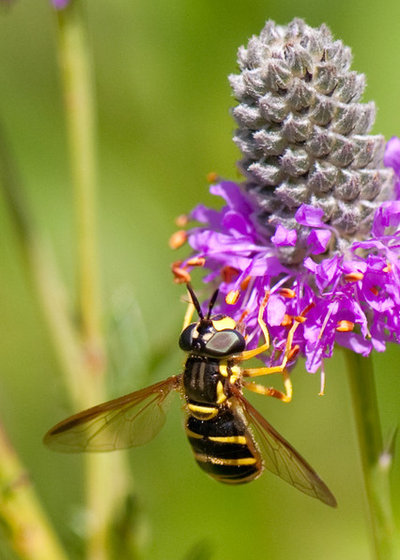
Holm Design & Consulting LLC
How to Spot a Syrphid FlyAdults. Don’t be fooled by their appearance; many syrphid fly adults are convincing mimics of bees or wasps. Often sporting a striped or spotted pattern, syrphid flies use this ingenious strategy to make themselves look menacing to potential predators. Because syrphid flies resemble these stinging insects, their predators, such as birds, are less likely to take a bite out of them.
To visually distinguish syrphid flies from bees or wasps, look at the length of their antennae. Flies usually have short, stubby antennae, whereas bees and wasps have longer, “normal”-length or proportional antennae. Syrphid flies also have large eyes that encompass more of the head than in bees or wasps. Like all flies, syrphid flies have only two wings, one on each side; bees and wasps have four wings, two on each side, but sometimes they appear as two because the wings are hooked together.
Adult syrphid flies are very good fliers; many have the ability to hover and dart quickly from side to side, forward and backward.
Shown: Chrysotoxum sp on purple prairie clover (
Dalea purpurea)
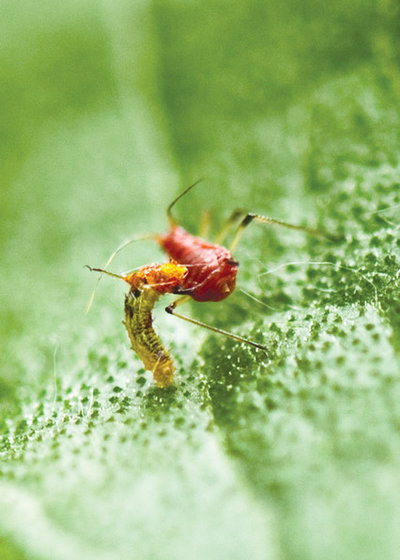
Holm Design & Consulting LLC
Babies (larvae). The larvae look like caterpillars, with elongated, legless bodies. They often have distinctive coloration or markings; some are smooth and light green to translucent in color, while others have stripes or a spiny appearance.
Shown: A syrphid larva feeding on an aphid
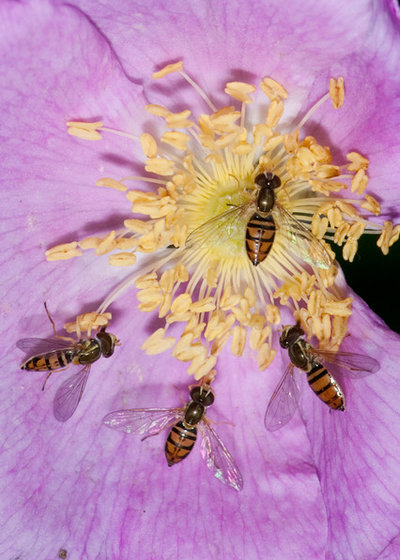
Holm Design & Consulting LLC
How to Lure ThemSyrphidae adults are regular flower visitors, and many consume both nectar and pollen. They are considered effective pollinators of many types of plants. Female syrphid flies feed on pollen, a source of protein that nourishes egg production. Using their sponge-like mouthparts, females often hold anthers with their forelegs as they lap up the pollen. Providing a pesticide-free garden with a variety of flowering plants throughout the season will attract many types of syrphid flies.
Forage plants for adults. Adults like open flower forms where the floral resources are easy to access, including plants in the Asteraceae (aster), Ranunculaceae (buttercup), Apiaceae (parsley) and Rosaecea (rose) families. Complex flower forms with narrow corollas limit nectar access to syrphid flies, all of which have short tongues. Adult syprhid flies also feed on pollen from grass and sedge species, especially in early spring, when other forage is in limited supply.
Leaving leaf litter is very important, as many syrphid flies overwinter under leaf litter, where they find protection from winter temperatures. Some species overwinter as larvae; others as pupae or adults.
Sample plant list for adults:- Early spring: Virginia waterleaf (Hydrophyllum virginianum), marsh marigold (Caltha palustris) and Sprengel’s sedge (Carex sprengelii)
- Spring: Ohio spiderwort (Tradescantia ohiensis), cicely (Osmorhiza spp), Canada anemone (Anemone canadensis), wild rose (Rosa blanda), Greek valerian (Polemonium reptans), Golden Alexanders (Zizia aurea) and Beardtongue (Penstemon spp)
- Summer: Black-eyed Susan (Rudbeckia hirta), great St. John’s wort (Hypericum pyramidatum), false sunflower (Heliopsis helianthoides), prairie cinquefoil (Potentilla arguta), purple prairie clover (Dalea purpurea) and blazingstar (Liatris spp.)
- Fall: Stiff goldenrod (Solidago rigida), zigzag goldenrod (Solidago flexicaulis), showy goldenrod (Solidago speciosa) and asters (any species)
Shown: Toxomerus marginatis on
Rosa blanda
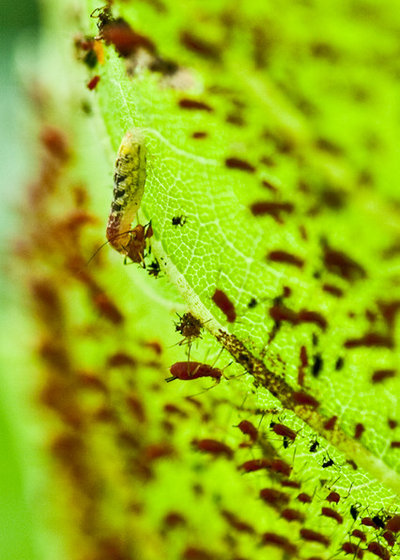
Holm Design & Consulting LLC
Prey for larvae. Syrphid flies are predaceous as larvae; their diet consists primarily of other insects. Prey includes aphids, spider mites, insect eggs, thrips, scales and mealybugs. If insect prey is unavailable, some
Syrphinae larvae will consume pollen.
Sample plant list for larvae: Any plant that is afflicted by aphids, such as
Heliopsis spp,
Silphium spp or milkweed (
Asclepias incarnata)
Shown: Larvae feeding on aphids on the underside of a cup plant leaf
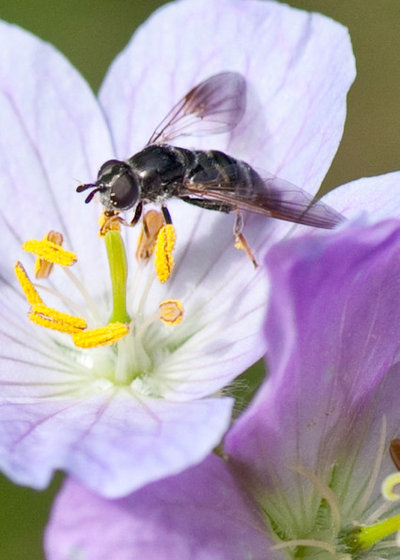
Holm Design & Consulting LLC
Life cycle. Syrphid flies undergo a complete metamorphosis, from egg to three larval stages to puparium and then adult. Females look for aphid populations on plants and lay either a single egg or clusters of eggs on the underside of leaves near the aphids. The eggs are white- to cream-colored and have an elongated oval shape. The larvae hatch within three days and crawl to their prey on the plant’s foliage.
Larvae can be voracious predators, often attacking aphids larger than themselves. When ready to pupate, the larvae attach themselves to a leaf or plant stem. Some syrphid flies overwinter as pupae, the pupae remaining in the leaf litter until spring. Adults typically live from three to nine weeks.
Shown: Pipiza sp feeding on pollen on a wild geranium (
Geranium maculatum) flower.
Pipiza syrphid flies are specialists; the larvae feed exclusively on gall-forming aphids.
Region by Region: What to Do in Your Garden This Month





